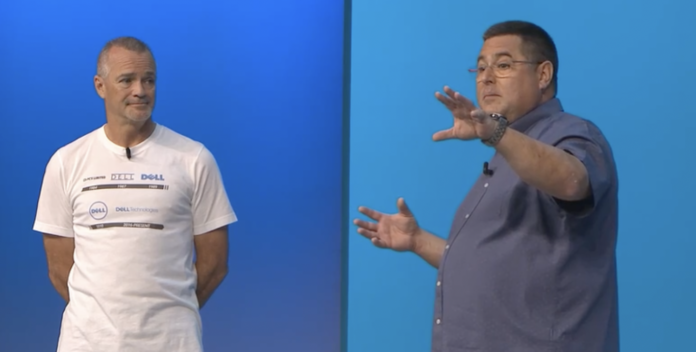The NativeEdge software platform debuted at the recent Dell Tech World event
While Dell Technologies is rapidly growing its Telecom Systems Business with a focus on disaggregated and distributed networking, the company has a very large, long-term business at the enterprise edge. In fact, more than 81% of Fortune 100 enterprises use Dell edge solutions. While there’s clear opportunity at the overlap of private networks and edge computing—opportunity Dell is poised to take—operators are slow to capture material new service revenues from these types of custom, on-prem solutions. To get a better view of the larger edge picture, and perhaps understand what operators (and their partners) can do better, RCR Wireless News sat down with Dell SVP of Edge Portfolio and Solutions Gil Shneorson in Las Vegas, Nevada, during Dell Tech World.
Because enterprises want to stand up low latency use cases and speed, and automate, decision making, and because they need to ensure compliance with data security and sovereignty requirements, “Compute is shifting towards edge locations,” Shneorson said, citing things like machine vision and streaming sensor data. “It’s almost a perfect storm…And when that happens we have a new problem because unlike a data center, edge compute is done in locations where the network is not guaranteed. There’s nobody at the edge to help us deploy or manage. And this is all done at a scale that is far beyond the traditional data center.”
Outside of highly-controlled data center environments, at 20 manufacturing plants around the world, at a 1,000-location department store, at 30,000 fast food locations around the world, or at the bottom of thousands of cell towers, Dell is working to “address the management problem that exists when you have all those distributed devices out there that exist with all those constraints.”
That’s where the new NativeEdge software platform, announced during Dell Tech World, comes in. Key NativeEdge capabilities include scaled secure device onboarding, remote management, embedded zero trust security, and multicloud application orchestration; the solution also draws on Dell’s hardware portfolio. In company literature, Dell calls out a three-year, 130% ROI timeline, reduced deployment times and opex, a validated design for warehouse automation for the retail industry, and an expansion of the Dell Private Wireless Program to include Airspan and Druid. On that last one, Airspan is a RAN provider and Druid is a core software provider; Dell said it has packaged those two vendors’ kits into a “validated private wireless solution that gives enterprises reliable, secure wireless connectivity for thousands of remote edge locations,” and is “easily integrated with enterprise IT and operational technology (OT) systems and includes tailored implementation, end-to-end management and support.”
Back to Shneorson: NativeEdge represents a “re-think” of how to deliver digital transformation in a “world where there will be no IT at the edge to help us…The barrier to entry would be such that people could use an IoT gateway or an industrial PC or a server and still get the same consistency.” Another key consideration–also a primary point in Michael Dell’s day one keynote–is the prevalence of multicloud operations. “You have to be able to coexist in that environment. You cannot just ask customers to refactor applications.”
Deploying and running a “mega application” at the edge
Shneorson highlighted three aspects of NativeEdge that simplify the whole process for users, and accelerate time to value which underlies that ROI figure above:
- Easy, secure device onboarding where the user plugs in an edge gateway, PC or server, connects it to the network, “and you’re done. Everything else is configured remotely.”
- Remote management of those devices.
- And multicloud application and service orchestration. “We can now sit there in front of a catalog of applications and deploy them to edge locations automatically by simply creating blueprints and deciding which devices will be running which blueprint. If we are an organization that develops their own applications, we can connect those blueprints all the way out to their CI/CD pipeline which means for the first time ever somebody could develop an application and release it to multiple edge devices across the globe automatically.”
He continued: “We don’t think edge operations is only about the edge. If you have an application running in a store, it has some sort of software running in the store and some sort of aggregated software running in a data center, and monitoring in the cloud. All of those things make for one outcome, one mega application.”
In the broader sweep of industrial digital transformation, or Industry 4.0, if you like, there’s a longstanding discussion around how to best link up IT systems that transport sensor data and the OT systems that make sense of the data and take action. “If we can marry those two into an architectural platform,” Shneorson said, “we can save them a lot of money…They can start to think about how to run multiple workloads the same way…If we believe the customers, that is what they were looking for.”

